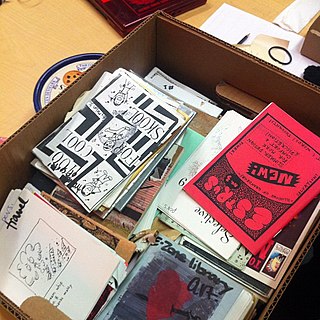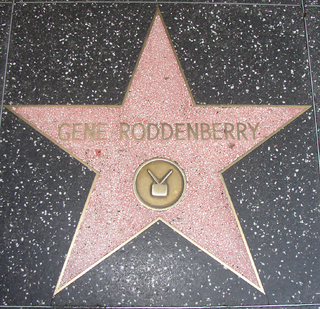
A fanzine is a non-professional and non-official publication produced by enthusiasts of a particular cultural phenomenon for the pleasure of others who share their interest. The term was coined in an October 1940 science fiction fanzine by Russ Chauvenet and first popularized within science fiction fandom, and from there the term was adopted by other communities.

A fandom is a subculture composed of fans characterized by a feeling of camaraderie with others who share a common interest. Fans typically are interested in even minor details of the objects of their fandom and spend a significant portion of their time and energy involved with their interest, often as a part of a social network with particular practices, differentiating fandom-affiliated people from those with only a casual interest.

Eugene Wesley Roddenberry Sr. was an American television screenwriter and producer who created the science fiction franchise Star Trek. Born in El Paso, Texas, Roddenberry grew up in Los Angeles, where his father was a police officer. Roddenberry flew 89 combat missions in the Army Air Forces during World War II and worked as a commercial pilot after the war. Later, he joined the Los Angeles Police Department and began to write for television.

Science fiction fandom or SF fandom is a community or fandom of people interested in science fiction in contact with one another based upon that interest. SF fandom has a life of its own, but not much in the way of formal organization.

A zine is a small-circulation self-published work of original or appropriated texts and images, usually reproduced via a copy machine. Zines are the product of either a single person or of a very small group, and are popularly photocopied into physical prints for circulation. A fanzine is a non-professional and non-official publication produced by enthusiasts of a particular cultural phenomenon for the pleasure of others who share their interest. The term was coined in an October 1940 science fiction fanzine by Russ Chauvenet and popularized within science fiction fandom, entering the Oxford English Dictionary in 1949.

Janice Rand is a fictional character in the American science fiction television series Star Trek: The Original Series during its first season, as well as three of the Star Trek films. She is the Captain's yeoman on board the USS Enterprise (NCC-1701), and first appeared in the episode "The Man Trap". She had significant roles in the episodes "The Enemy Within", where she fights off an evil version of Captain James T. Kirk; "Charlie X" where a young man with god-like powers falls in love with her; and "Miri" where she is infected with a deadly disease while on an away mission and is kidnapped by jealous children.

Fangoria is an internationally distributed American horror film fan magazine, in publication since 1979. It is published four times a year by Fangoria Publishing, LLC and is edited by Phil Nobile Jr.

Dorothy Catherine Fontana was an American television script writer and story editor, best known for her work on the original Star Trek series.
Betty JoAnne Trimble, known as Bjo, is an American science fiction fan and writer, initially entering fandom in the early 1950s.

Kirk/Spock, commonly abbreviated as K/S or Spirk and referring to James T. Kirk and Spock from Star Trek, is a popular pair in slash fiction, possibly the first slash pairing, according to Henry Jenkins, an early slash fiction scholar. Early in the history of Star Trek fan fiction, a few fan writers started writing about a romantic and sexual relationship between Kirk and Spock, highlighting a romantic or sexual element to the friendship between the men. As of 1998, most academic studies on slash fiction focused on Kirk/Spock, as Star Trek was by that point one of the longest-lived and most prosperous subjects of slash fiction, while its mainstream popularity made it one of the most accessible titles for academics and their audience. As the first slash pairing, K/S was created and developed largely independently from the influence of other slash fiction, with most of the conventions of the slash genre seeing their debut first in K/S slash.
Eric A. Stillwell is a producer and writer who has worked on a number of television series, made-for-television movies, and motion pictures, including numerous Star Trek series and motion pictures.

Tony Timpone is the former longtime editor of Fangoria magazine, as well as an author about the horror genre, a film festival programmer, and a producer/interviewer for horror-related TV and radio shows.
Stellar Occasion was a three-day science fiction convention held in the Dallas, Texas area in the mid to late 1990s. It blended science fiction literary and media guests with space science in an unusual, fan-oriented cross between the traditional science fiction convention and a commercial media event. Stellar Occasion is notable for being an early proponent of the television series Babylon 5 and featuring both writers and actors from the show each year.
Star Trek is an American science fiction media franchise created by Gene Roddenberry, which began with the eponymous 1960s television series and became a worldwide pop-culture phenomenon. Since its creation, the franchise has expanded into various films, television series, video games, novels, and comic books, and it has become one of the most recognizable and highest-grossing media franchises of all time.
Kerry O'Quinn is an American writer, magazine publisher, director and producer, most noted for the creation of Starlog, Fangoria, Cinemagic, Future Life, Rock Video, Hard Rock and Comics Scene magazines.

The Star Trek Concordance is a reference book by Bjo Trimble about the television series Star Trek. The first edition was self-published in 1969. A mass-market edition was published in 1976. The 1976 edition contains summaries from every episode of The Original Series and The Animated Series, as well as an encyclopedia of characters and technology from the series. It was used as a reference for later writers of the show.

Star Trek: The God Thing is an unproduced film script written by Star Trek series creator Gene Roddenberry. Following the success of Star Trek in broadcast syndication during the early 1970s, Paramount Pictures sought to produce a feature film based on the property. The film's plot follows the Enterprise crew after the events of The Original Series: when an alien entity declares itself God and begins travel to Earth, Admiral James T. Kirk reunites the crew, who send it back to its own dimension. Roddenberry completed the story on June 30, 1976, but Paramount rejected the script for reasons Roddenberry attributed to the religious views of company executives. Story elements were used in Star Trek V: The Final Frontier.

Eugene Wesley "Gene" Roddenberry was an American television screenwriter, producer and futurist best remembered for creating the original Star Trek television series.
Myrna Lou Culbreath is an American science fiction writer and editor, most well known for the Star Trek tie-in novels and anthologies cowritten with Sondra Marshak. Culbreath was a founding editor of the libertarian editorial magazine The Fire Bringer.
Camille Bacon-Smith is an American scholar and novelist. She has a Ph.D. in folklore and folklife from the University of Pennsylvania. Her books, Enterprising Women (1992) and Science Fiction Culture (1999), investigated science fiction fandom, including such aspects as slash fiction, hurt-comfort stories and Mary Sue characterization. Under her own name she has published an urban fantasy series beginning with Eye of the Daemon (1996). Under the pen name Curt Benjamin, she has written fantasy novels with an Asian setting, beginning with The Prince of Shadow (2001). In 2016 she began writing dance reviews for Broad Street Review, an online publication on Philadelphia arts and culture.















